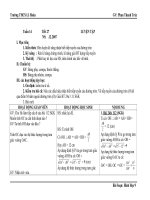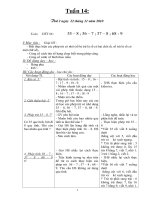Slides 14 3 calculate volume and performance variances for
Bạn đang xem bản rút gọn của tài liệu. Xem và tải ngay bản đầy đủ của tài liệu tại đây (4.73 MB, 84 trang )
Calculate Volume and
Performance Variances for Output-Based
Control Case Study Scenario
Letterkenny Army Depot
Intermediate Cost Analysis
and Management
© Dale R. Geiger 2011
1
Go to to play the video
© Dale R. Geiger 2011
2
Terminal Learning Objective
• Task: Calculate Volume and Performance Variances for OutputBased Control Case Study Scenario
• Condition: You are training to become an ACE with access to
ICAM course handouts, readings, and spreadsheet tools and
awareness of Operational Environment (OE)/Contemporary
Operational Environment (COE) variables and actors
• Standard: with at least 80% accuracy
• Describe the cost-rate-price structure at Letterkenny Army Depot
(LEAD)
• Calculate surcharge and price for depot services based on
Accumulated Operating Result (AOR)
• Discuss performance control issues in revolving funded organizations
© Dale R. Geiger 2011
3
© Dale R. Geiger 2011
4
© Dale R. Geiger 2011
5
© Dale R. Geiger 2011
6
© Dale R. Geiger 2011
7
© Dale R. Geiger 2011
8
© Dale R. Geiger 2011
9
© Dale R. Geiger 2011
10
© Dale R. Geiger 2011
11
© Dale R. Geiger 2011
12
Letterkenny Army Depot
Teaching Points
Letterkenny is typical of many, manufacturing-like revolving funded
operations that have common issues:
1. Price Setting: non appropriated organizations generate revenue
by providing goods or services
• This requires a mechanism to set prices
• How does this work?
2. Performance Evaluation
• Does “revenue less cost” yield a meaningful performance measure?
• How important is volume variance in manufacturing operations with
significant fixed costs?
• How does one evaluate performance in such a complex environment?
© Dale R. Geiger 2011
13
Price Setting in the Business World
• The theory in the business world is that the market
sets the price
• The forces of supply and demand clear the market at an
efficient price
• This appears to work fairly well for commodity goods
• There are circumstances where this doesn’t apply
• Specialty items where there is not a market and/or
there are significant barriers to entry
• Internal transfers where one division of a company sells
to another (vertical integration)
© Dale R. Geiger 2011
14
Price Setting in Government
• Most government organizations are funded by
appropriation and have no pricing
• Some are non-appropriated and generate revenues
by charging for their goods or services
• Usually not competing in the market place so market
pricing not applicable
• Sometimes there are social motivations to consider
• Budget constraints are expected to increase the
interest of government organizations in charging for
services
© Dale R. Geiger 2011
15
Price Setting in Government: Examples
• Public water department:
• Sets price of water to cover all costs of water acquisition
and delivery
• May also include a sewer charge
• Parking meter:
• Covers more than the costs of meters
• Provides revenue source to cover other city costs
• Public bus fare:
• Covers less than the costs of transportation
• Subsidized by appropriated funds to encourage use
© Dale R. Geiger 2011
16
Consider Some Federal Examples
• National Institutes of Health: Supply and Service Fund
• Supplies thousands of laboratory supply items via catalog
• Competes with outside sources
• General Services Administration: Public Building Service
• Charges all users a basic standard charge
• Provides optional services on a fee basis
• National Institutes of Health: Management Fund
• Maintains capabilities but doesn’t charge on basis of usage
• Negotiates agreements from users like an allocation
• U.S. Army: Army Material Command
• Sets prices for outputs based on previous profit and loss record
• Over time profits and losses offset each other
© Dale R. Geiger 2011
17
Revolving Fund Pricing
• The Army has many non-appropriated organizations: depots,
labs, arsenals
• These are sometimes called revolving, industrial, stock,
enterprise, or working capital funded
• Usually have no social motivation or political agenda
• Generally have no comparable free market
• Represent internal transfers
• General rule is that the price or user fee must reimburse the
costs of providing the goods or services
• Some “contracts” specify frequent invoices of incurred cost
• Other “contracts” utilize a “stabilized pricing” practice that gives
customers a firm price for the budgeted years
© Dale R. Geiger 2011
18
Stabilized Pricing Objectives
• The rationale behind stabilized pricing is that government
customers value stability
• Customers are appropriated organizations subject to AntiDeficiency Act violation
• Changing incurred costs would create problems
• Increased incurred costs reduce the quantity that can be purchased or
create ADA violations
• Decreased incurred costs increase the quantity that could be
purchased or result in unused budget
• The revolving funded organization absorbs the variations of
incurred cost to stabilized price:
• Adjusts future years pricing accordingly
• (Incurring cash flow risk in the process)
© Dale R. Geiger 2011
19
Stabilized Pricing Process
•
•
•
•
Books a gain or loss in the current period
Adds a compensating pricing surcharge to the third year
Seeks a long run breakeven = full reimbursement
Timing issues result in a three year lag
• Execution Year: Uses prices set in previously and books a
gain or loss compared to incurred cost
• Budget Year: Experience in execution year is evaluated
and projected into Budget Year +1 pricing
• Budget Year +1: Uses prices set in budget year based on
execution year experience
© Dale R. Geiger 2011
20
AMC Pricing Sequence
• NOR (net operating revenue) is the AMC term for profit
Year -2
Year -1
Execution
Year
Budget
Year
Budget
Year +1
units
units
units
units
units
price
price
price
price
price
Revenue Revenue
Revenue
Revenue Revenue
Cost
Cost
Cost
Cost
Cost
NOR
NOR
NOR
NOR
NOR
• The goal is that NOR over time (AOR) is zero
© Dale R. Geiger 2011
21
AMC Pricing Sequence
• NOR (net operating revenue) is the AMC term for profit
Year -2
Year -1
Execution
Year
Budget
Year
Budget
Year +1
units
units
units
units
units
price
price
price
price
price
Revenue Revenue
Revenue
note the
time lags
Revenue Revenue
Cost
Cost
Cost
Cost
Cost
NOR
NOR
NOR
NOR
NOR
• The goal is that NOR over time (AOR) is zero
© Dale R. Geiger 2011
22
ISO 9001
Why do we have “rates”?
• Industrial Operations (AWCF) sites are
different from Appropriated (OMA) funded
installations
• Army Working Capital Fund is a Revolving
Fund account
ISO 14001
ISO 9001
OMA Basis
•
For example Ft Belvoir, Ft Detrick and Ft Meade
•
Are provided annual operating funds from various
Operations and Maintenance, Army sub accounts:
– To pay military and civilian employee salaries and
benefits
– To pay utility bills
– To fund real property maintenance and improvements
– To maintain its vehicle fleet (to include Motor Pool)
– To fuel and operate vehicles, facilities and base
infrastructure
• Technically this is termed OBLIGATION AUTHORITY
ISO 14001
ISO 9001
Industrial Sites
• Do not receive Operating Funds
• We receive orders to execute assigned
missions that involve core competencies,
or new missions
• We are granted “Cost Authority”, which
allows us to incur costs that must be
recovered via “rates”
ISO 14001









